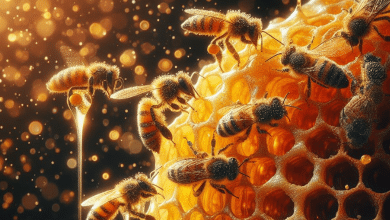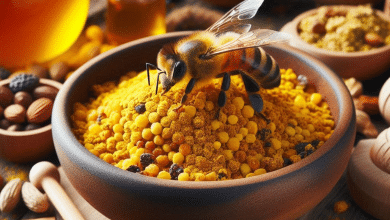How to keep and create honey?

I know you wonder how bees create honey, So today we will take a look about this process.

Bees use two distinct and simultaneous processes to create honey from nectar:
The first involves a chemical conversion of sugar.
The second involves a natural change in the water content caused by evaporating excess water.
Once the honey is fully matured, the hexagonal eyes containing it are covered with wax.
Invertase breaks down sucrose into glucose and fructose, two straightforward monosaccharides.

When the housemaid gets the load of the field worker from the nectar, she travels in the cell to an open space and then assumes a distinctive position where she makes the longitudinal axis of her body perpendicular to the top of her head. This causes the water content of the nectar to evaporate.
1- Beginning with her mouth parts in a resting position with her upper jaws wide open and moving the hose forward and downward.
2- At the same time, the hose’s far end vibrates and spins slightly outward, causing a tiny drop of nectar to arrive in the front of the oral cavity. The hose then rises and shrinks to a resting position, but after each reduction, it rises again. Only when starting to return to its resting position does the far end of the hose vibrate less outward than it did previously.

3- The amount of nectar that appears increases together with the second decrease in the hose A drop of nectar occurs in the front cavity of the mouth when some of it starts to flow on the hose’s upper surface and with the second rise and contraction of the hose.
4- Until it reaches its maximum size, this drop grows in size each time the hose alternates between being lower and higher.
5- In final step to create honey, the bee then draws the entire drop of nectar into its body. As the nectar is sucked in, the drop’s surface becomes concave as the hose’s end extends until the drop vanishes. The hose is then bent back again to rest.
This is the first step to create honey…When this stage of maturation is complete, the domestic worker bee looks for a hexagonal eye in which to deposit the concentrated drop, and if the hexagonal eye is empty, the bee enters it. Typically, the domestic worker bee takes between 5 and 10 seconds to complete the previous series of tasks, and these procedures are repeated for about 20 minutes with a brief break The nectar is ejected on the upper surface of the proboscis between the upper jaws that the bee makes far from each other until its upper jaws touch the upper corner of the back of the hexagonal eye, at which point the immature honey is painted on the upper wall of the hexagonal eye using the mouth parts as a brush and the bee turns its head from one side to the other to occupy the back of the hexagonal eye.
If the honey-filled hexagonal eye is present, the bee adds its drop without first applying paint by dipping its upper jaws into the honey to create honey.
Chemical transformation to create honey:

During the first process as well, sucrose is converted into the two monosaccharides (glucose and fructose), which is the second and most crucial stage in the honey ripening process. During the nectar’s circulation before it is deposited in the disk, the invertase enzyme is added, and over the course of several hours, the nectar progressively turns into honey.
It was discovered that the temperature and humidity inside the cell have a direct and opposite effect on the rate of evaporation of water from the nectar, respectively. This is because air movement inside the cell accelerates evaporation at a rate proportional to air movement, but the rate of evaporation decreases as the air gets closer to its saturation point with moisture. This is the way to create honey by honey bee.
Check our Article of you are interesting in honey bee.







